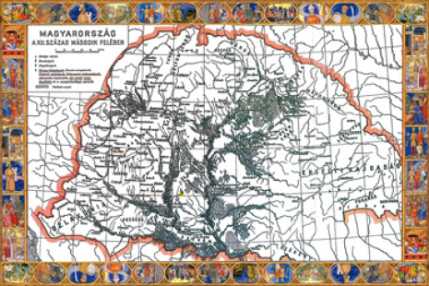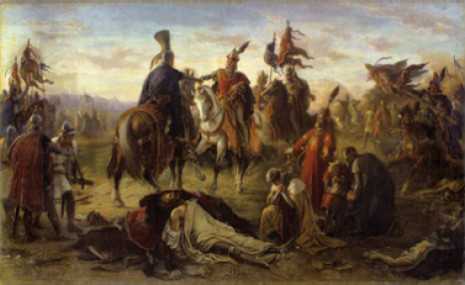The Battle of Morvamező – August 26, 1278
Szöveg: hungariandefence.com | 2011. augusztus 26. 8:07The battle of Morvamező (Marchfeld) was fought seven hundred and thirty-three years ago, on the 26th of August, 1278, where the Armies of Rudolph of Habsburg, the German King and Ladislaus IV (the Cuman), King of Hungary, gained a decisive victory over the then most powerful Prince of the German Roman Empire, Ottokar (Przemysl Otakar II), the King of Bohemia. We commemorate the historic event by excerpting from the publication of Zrínyi Média entitled “For the Homeland Unto Death – 1100 Years”, which is available in our Digital Library.
In 1273, the German princes elected
Rudolf Habsburg as their king in preference
to the very powerful Ottokar. Aggravating the
conflict between them was that the German
imperial Diet obliged Ottokar to hand over
Austria, Styria, Carinthia and Krajina to Rudolf,
permitting him to retain only Bohemia and
Moravia. Ottokar was naturally disinclined to
hand over lands which in many cases he had
acquired often after a hard struggle, and Rudolf
was also aware that without military strength he
could not implement what the Diet had granted
him. It was a situation in which the King of
Hungary could tip the balance. Ottokar offered
peace to King Ladislas on favourable terms, but
the inveterate anti-Bohemian barons at court
held sway over the young King’s decisions.
They saw their chance of defeating a dangerous
enemy through alliance with Rudolf. The pact
against the King of Bohemia was made in 1277.
In the first five years of his rule, Rudolf
was not able to consolidate his power over the
German princes, who saw him as a rival rather
than a leader. An indication of his unpopularity
is that the Poles, Bavarians, Styrians and
Viennese burghers all stood under Ottokar’s
banner.
Ottokar set off from Prague towards the
River Morava on 27 June. Progressing slowly,
he gathered his army together. In the meantime,
Rudolf waited in Vienna, having set the date of
8 September for the gathering of his troops.
Ottokar knew that many had ignored Rudolf ’s
command, and did not hurry, confident that his
enemy could only put together a small army.
The Bohemian army entered Austrian territory
in late July. First they besieged Drossendorf for
16 days and then turned against Laa.
The only way Rudolf could see out of his
plight was to invoke Hungarian assistance. First
the vanguard led by Palatine Máté Csák marched
to the Austrian border, followed one month
later by King Ladislas IV’s 2000-2500 heavy and
medium cavalry and 500 Cumans, who camped
at Pozsony on 6 August. On 17 August, György
Baksa Simonfia led 8000 troops from the
vanguard to harry the enemy, still forming up,
in the Laa area, unsettling them with constant
attacks. Upon being informed of the support
by Hungarian forces, Rudolf wasted no time
and set off with the 2500 or so knights he had
mustered. The two armies united at Marchegg
on 23 August. From there they marched to
Dürnkrut, where the Hungarian army pitched
camp on the west of the hills ranging to the south
of the River Weidenbach, and the Austrians on
the east, towards the River Morava. Ottokar’s
army was encamped to the north east of them,
close to Dürnkrut. In the following days, the
Hungarian and Cuman light cavalry went on
active reconnaissance, thoroughly surveying the
proposed battlefield and clashing with the Poles
and Brandenburgers covering the enemy camp.
After one sizeable skirmish, the Cumans threw
100 enemy heads on to a pile in front of the
generals.

armies were allies, they were not put under a
single commander. Decisions were made at joint
councils of war, including the battle order which
the two armies were to take up. The Hungarian
and German armies were to form up in two
separate orders of battle. The Hungarians stood
on the left, in three formations. The first was
commanded by Palatine Máté Csák, the second
by Lord Chief Justice Stephen Gutkeled. The
third formation was held in reserve, and stood
to the rear, around a hill, commanded by King
Ladislas. The weapons of the Hungarian knights
did not gleam like those of their Western
counterparts, but they had among their ranks
the flower of the northern and western county
nobility, knights hardened in battle. In the first
ranks stood Péter Csák, older brother of Máté,
Lord Chief Justice Stephen Gutkeled, and
Amádé Aba. The Germans on the right wing
also had three formations. The first comprised
Austrians, the second Swabian, Styrian and
Carinthian knights led by Rudolf, and behind
them, well hidden from the enemy, a 50-knight
squadron under Kapeller Ulrik, held in reserve.
On each wing, the first two formations consisted
of 1000 heavily armoured knights. The Cumans
covered the wings of the battle order. It was
they who, during their scouting sorties of the
previous days, had thoroughly surveyed the
battleground and found that the marshy river
dividing the two armies had dried up and would
be no obstacle to the cavalry charge.
Ottokar divided his army into a right and
left wing, each standing in three lines of battle.
The right wing, facing the Hungarians, was
commanded by Milota of Dedic, Ottokar’s
former Styrian governor. Here, Bohemians
made up most of the first line, Moravians the
second and Poles the third. Ottokar did not have
a high regard for the Hungarian heavy cavalry,
and so set his troops of higher combat value
on the left wing, under his own command. The
first line comprised Meissen and Thuringian
mercenaries, the second selected Poles, and the
third Bavarians and Brandenburgers.
At Rudolf ’s request, the date of battle was set
for 26 August. It was the delay by the German
army that put the allied forces into something
like a crisis. At the final council of war it was
agreed that they would mount the attack ahead
of the Bohemians, but the German army heard
Mass in the morning, then the commanders
took confession, and finally Rudolf delivered
rousing words to his knights. In the meantime,
the Hungarian battle order had taken its place
on the left wing. Opposite, Ottokar’s army was
fully assembled and waiting. Sooner or later, the
vulnerability of the right wing could have been
noticed. The key to the situation was the sending
ahead of the Cumans. After nine o’clock,
the boldly attacking light cavalry surrounded
Ottokar’s battle order and released a hail of
arrows upon them. The swirling horsemen and
the dust they threw up effectively veiled the
Germans, who were coming into position. The
Hungarian battle order, seeing that Rudolf ’s
first lines were in place, without hesitation
charged at the right wing opposite, which was
unable to prepare to repel them because of the
Cumans. With a slight delay, the Austrians on
the right wing also joined the charge. In this
period, the light cavalry moved outward to the
wings, where they put their ranks in order and
started to attack the troops on the wings and
rear of the enemy. This bore fruit mainly on
the Bohemian right wing, where the Hungarian
heavy cavalry, in fierce close-quarters combat,
had overcome the first two lines, while the light
cavalry obstructed deployment of the Poles in
the third line. The Bohemian right wing, being
forced back, eventually turned and ran, and the
pursuing Hungarians also captured the enemy
camp. The gallantry of the Hungarian knights
surprised even their German allies. “No flail has
ever flailed," wrote a later German chronicler,
“than Palatine Mátyus and the knights who
stood with him in the battle; the Hungarians
wielded their swords as if they had studied in
France." It was indicative of the ferocity of the
battle that in the grim struggle, Palatine Máté
Csák, leading the first battle formation, came
close to death when he was swept off his horse,
and only escaped after Dénes Péterfia of the
Osl clan helped him back on.

less promising. Rudolf ’s attack was halted
by Ottokar’s first line of battle, and upon
deployment of the second, began to be pushed
back. Rudolf deployed his second line against
the pursuing Bohemians, and succeeded in
halting the enemy at Weidenbach. Fortune was
on the side of the Germans, although Rudolf
nearly had to pay for it with his life. When
crossing the Weidenbach, his horse tripped, and
the King of the Germans found himself under
the hooves of the galloping horses. He did not
fall into a panic, however, but lay covered by his
shield until the Swiss knight Walter Ramswag
freed him from his predicament. The confusion
caused by Rudolf’s accident was heightened
by Ottokar’s deployment of his third line.
The Bohemians’ momentum forced back the
Germans, whose retreat took them ever closer
to the Morava. That was when the troop led
by Kappeller Ulrik, who were waiting in a
valley in one of the hills around the Morava
flood plain, went into action. Seeing the army’s
retreat, they waited until the fray had passed
them, and then with a tremendous charge burst
upon the Bohemian flank. The unexpected
attack completely disrupted the disordered
body of the pursuers and, taking advantage
of the confusion, Rudolf ’s troops resumed
their charge. At this point, the Hungarian
heavy cavalry, having turned back from pursuit,
appeared at the Bohemians’ rear. Seeing that the
battle was lost, Ottokar tried to escape with a
small band, but could not break through the ring
of Austrians. His horse fell, and in his desperate
situation, he chose surrender. Shouting his name
out loud, he declared he was not continuing
the battle. His attackers, however, were driven
by vengeance. After they recognised him, they
attacked with renewed ruthlessness, cutting and
stabbing. He eventually lay bleeding from 17
wounds. His vanquishers still knew no mercy,
and unchivalrously looted him of his clothes.
Ottokar’s army suffered a fatal defeat.
Authoritative estimates put the number of his
knights who lay dead on the battlefield at more
than 10,000. Many of those who took flight
were looted by the Cumans, and many met their
deaths in the waters of the Morava. The victors
took an enormous booty. The Cumans above
all gathered up piles of valuables. There were
rumours they even considered attacking and
looting the camp of the Austrian allies. A few
days later, the victors left the battlefield. Rudolf
set off north to Bohemia. The Hungarian army
made straight for Székesfehérvár, where they
gave thanks to God for victory.